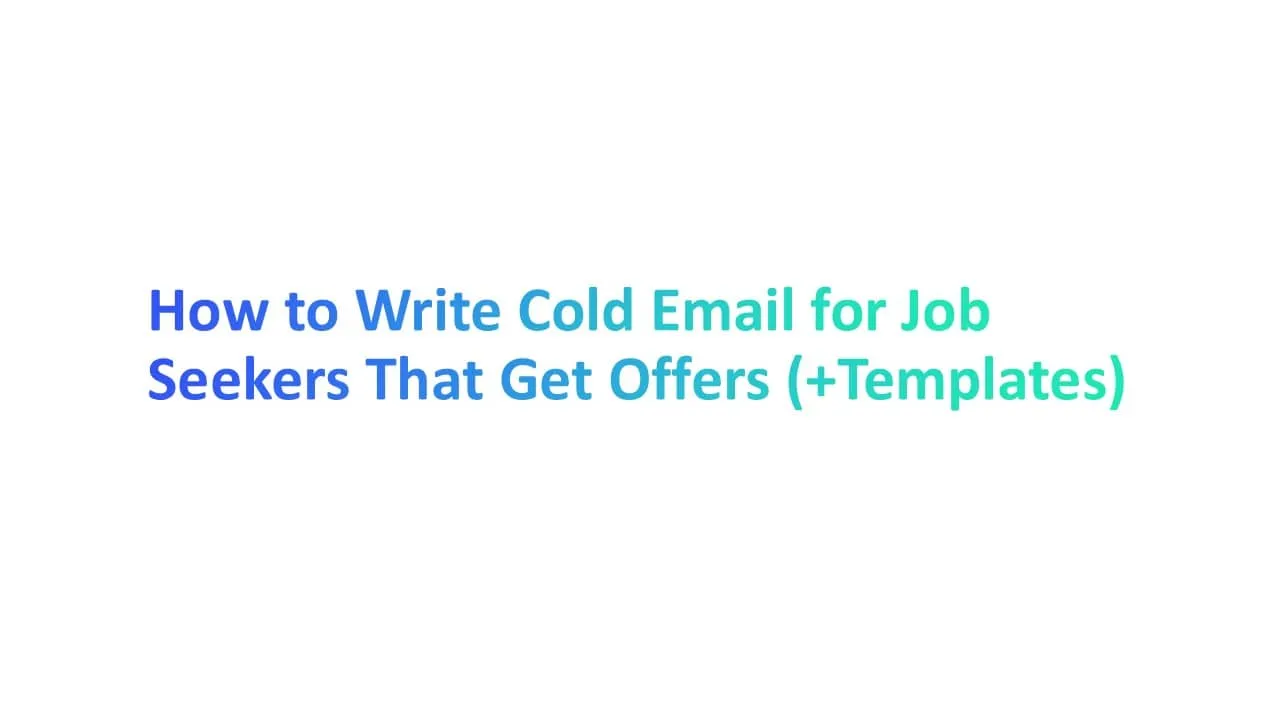Tired of sending job applications into the void? You're not alone. According to Jobvite’s 2024 Recruiter Nation Report, only 8% of candidates get a response through traditional job boards.
That’s where cold emailing comes in—and no, it’s not just for pushy salespeople. When done right, a cold email can land you interviews faster than waiting on “Easy Apply.” Cold emailing gives you an edge in a crowded job search by helping you skip the application pile.
In this guide, you’ll learn exactly how to write a cold email for job opportunities, even if there's no posting.
We’ll give you proven templates, expert tips, and a few laugh-worthy don’ts—so your email actually gets opened (and replied to).
What Is a Cold Email for Job and Why It Still Works in 2025

A cold email for job is a message you send to someone at a company—even if there’s no job posting. You don’t wait for a listing. You make the first move. It’s like saying, “Hi, here’s what I can do—are you hiring?”
Think of cold emailing as the modern version of cold calling—only more polite and scalable. And yes, it still works in 2025. Here's why:
Why Cold Emails Still Work
- 80% of job openings aren’t listed on public job boards (source: CNBC).
- Cold emails help you reach the right person—often the hiring manager—before others apply.
- It shows genuine interest and makes you look like a valuable asset, not just another applicant.
What Makes It Work So Well
- You can match your relevant experience to the company’s needs.
- You’re not competing with 500 people from a job posting.
- It can lead to a job interview, a referral, or even a dream job.
“When someone emails me directly with clear intent, I always read it—even if I’m not hiring.”
— Hiring Manager at a U.S.-based SaaS company, 2024 survey
When to Use Cold Email Job Inquiries (And When Not To)
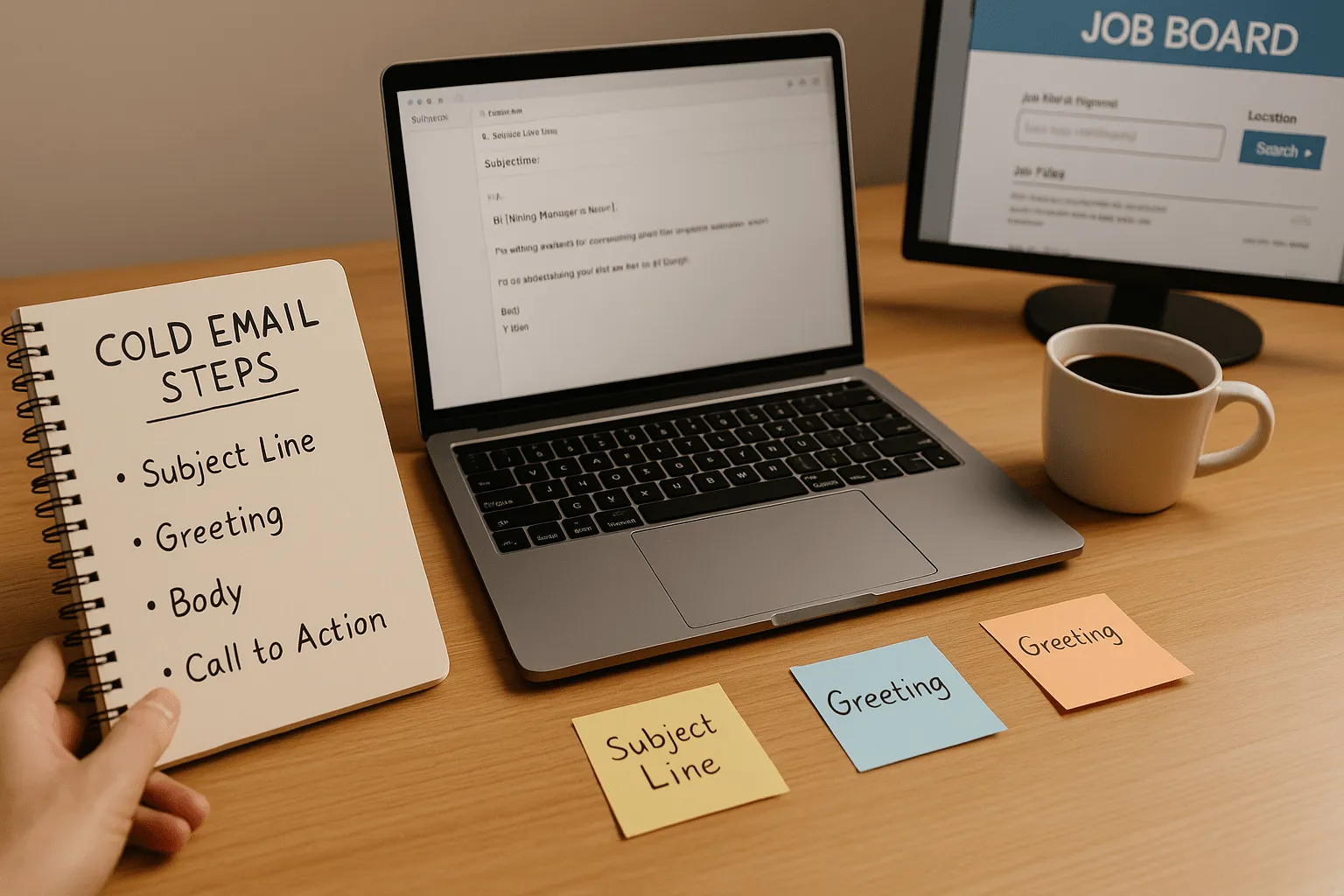
Sending a cold email for job is smart—but only when the time is right. If you don’t see a job posting but really like the company name or admire their company’s journey, send one. You can also use it to reach a hiring manager directly, even before the role is live.
Use a Cold Email When:
- Your skills align with the company’s work.
- You’re targeting a dream job at your dream company.
- You want to get ahead of public job openings or job boards.
Don’t Use It When:
- The job application says “no emails, apply only.”
- You haven’t done any research.
- Your email body looks like a copy-paste from a cold email template.
"Over 70% of companies say proactive outreach shows serious intent." – LinkedIn Hiring Trends 2024
Make sure your message adds value. That’s how you stand out to potential employers.
How to Write a Cold Email for a Job (Step-by-Step Guide)

1. Find the Right Person to Email (Not Just HR)
To write effective cold emails, focus on being relevant, personal, and brief—less is often more.
Don’t just send your cold email for job to a generic “careers@company.com.” You want to send it to someone real—a hiring manager, a team lead, or even the right person from the department you want to join.
How to do it:
- Use LinkedIn to look up people who work in the team you're interested in.
- Check the company website for leadership names and job team contacts.
- If you saw a job posting, note who signed it or what department it's in.
- Aim to message someone who can influence the hiring process, not just an automated inbox.
Why it works: According to Zippia (2024), emails sent directly to a person have a 35% higher reply rate than those sent to generic addresses. Personalized cold emails can improve response rates by up to 50%, especially when you show real interest in the company’s work.
People appreciate being addressed personally—and it helps you skip the crowd of job boards and mass applicants.
Tips to Find the Right Person:
- Search “[Job Title] + [Company Name]” on LinkedIn.
- Look under the “People” tab on the company’s profile.
- If unsure, email and politely ask, “Could you point me to the person who handles [Job Title] applications?”
2. Start with a Genuine and Personalized Opening Line
Use insights from a webinar or networking event to craft a personalized opening line that gets attention.
Don’t start with “Dear Sir/Madam” or jump right into your resume. First, show them you did your homework. Mention something real about the company name, their company’s journey, or a recent project you liked. This creates a personal connection.
How to do it:
- Mention a blog, product, or update from the company’s work that impressed you.
- Use a shared interest if you saw the person speak at an event or webinar.
- Add a line that shows your genuine interest in the role or company’s mission.
Why it works: People open emails that feel human. A great subject line helps, but a warm email body seals the deal. When your opening lines are thoughtful, it builds instant connection.
Examples of Strong Opening Lines:
- “I’ve been following [Company Name]'s product updates, and I’m really impressed by how you help small businesses grow.”
- “I watched your team’s webinar last week and loved your take on the future of [specific industry].”
"Candidates who personalize their outreach are 52% more likely to receive a response." – Glassdoor 2023 Survey
3. Write a Compelling Subject Line That Gets Opened
Strong cold email subject lines can increase your open rate by up to 45%, according to 2024 recruiter data.
The subject line is the first thing a person sees. If it’s boring or unclear, your cold email for job won’t get opened. You need a line that grabs attention but still feels real.
How to do it:
- Include the job title or the company name.
- Keep it short—under 60 characters is best.
- Mention your value or intent clearly.
- Avoid spammy words like “urgent” or “guaranteed.”
Why it works: A compelling subject line shows you care and that your email isn’t just another copy-paste.
Avoid this:
- “Looking for a job”
- “Please hire me”
These don’t build confidence in potential employers.
4. Make the Email Body Clear and Easy to Skim
The email body is where you explain who you are and what you want—but quickly. Long, messy emails don’t get read. Clean formatting makes your cold email job inquiries look professional.
How to do it:
- Start with a short intro: who you are and why you’re writing.
- Mention relevant experience and 1–2 relevant skills.
- Show how your skills align with the company’s needs.
- Add a resume link or portfolio if possible.
- End with a simple call to action, like “Would you be open to a short call?”
Quick Format You Can Follow:
- Opening line: Mention shared interest or where you found the company.
- 1–2 sentences: Talk about your job application or career goal.
- 1–2 sentences: Share a success or experience related to the job posting or job description.
- Closing: Add your resume link and ask for a reply or quick call.
5. Include a Simple Call to Action
Once you’ve shared your background and job title, don’t end your email with silence. You need to ask for something—this is your call to action (CTA). It helps the reader know what to do next.
How to do it:
- Ask for a short call, Zoom chat, or coffee meeting.
- Keep it light. Don’t ask for a job right away.
- Show interest in learning more about the hiring process, team, or job opportunity.
Example CTAs to use:
- “Would you be open to a quick 10-minute call this week?”
- “Can I send over my resume to the right person on your team?”
- “I’d love to hear how your team approaches [specific job function].”
6. End with a Professional Sign Off
The way you end your cold email for job says a lot about you. Your sign off should feel warm but still professional. It leaves the last impression.
How to do it:
- Thank them for their time.
- Show you’re excited about future job openings or even an informational interview.
- Include your resume link, phone number, and email for a job response.
Best sign offs to try: A professional sign off like 'Kind regards' helps you sound polite and respectful while keeping the tone friendly.
- “Thank you again for your time—looking forward to hearing from you.”
- “Warm regards, [Your Name]”
- “Excited to stay in touch. Here’s my resume link in case it’s helpful.”
Why it matters: A polished sign off gives your email structure. It also shows professionalism and genuine interest—something that helps you stand out from other job seekers.
7. Follow Up Email If You Don’t Hear Back
A follow up email is what you send when your cold email for a job gets no reply. It shows that you're still interested and serious about the job opportunity during the application process . According to LinkedIn, 55% of hiring managers say that following up shows motivation.
How to do it:
- Keep it short, polite, and focused. Don’t sound pushy.
- Remind them who you are and why you're a good fit.
- Use this chance to show your genuine interest and highlight one more reason why your skills align with the role.
Subject Line Phrases That Gets Opened
High-Converting Cold Email Templates for Job Seekers
Template 1: Cold Email for a Job That’s Not Advertised
(Use this when there’s no job posting but you admire the company.)
Template 2: Cold Email in Response to a Job Posting
(Use this when replying to a public job listing with a cold email angle.)
Template 3: Cold Email for Informational Interview (Networking Purpose)
(Use this for building connections that lead to potential job opportunities later.)
Template 4: Cold Email via Mutual Connection (Referral Angle)
(Use this when you’ve networked and want to leverage a warm intro for a cold email job inquiry.)
Template 5: Cold Email to a Startup or Company in Private Beta
(Best for cold emailing startups that aren’t hiring publicly yet but could use help.)
Template 6: Pitching Your Dream Job at Your Dream Company
(Perfect for job seekers targeting a specific company with no listed job openings.)
How to Customize Your Cold Email for Any Specific Job or Industry
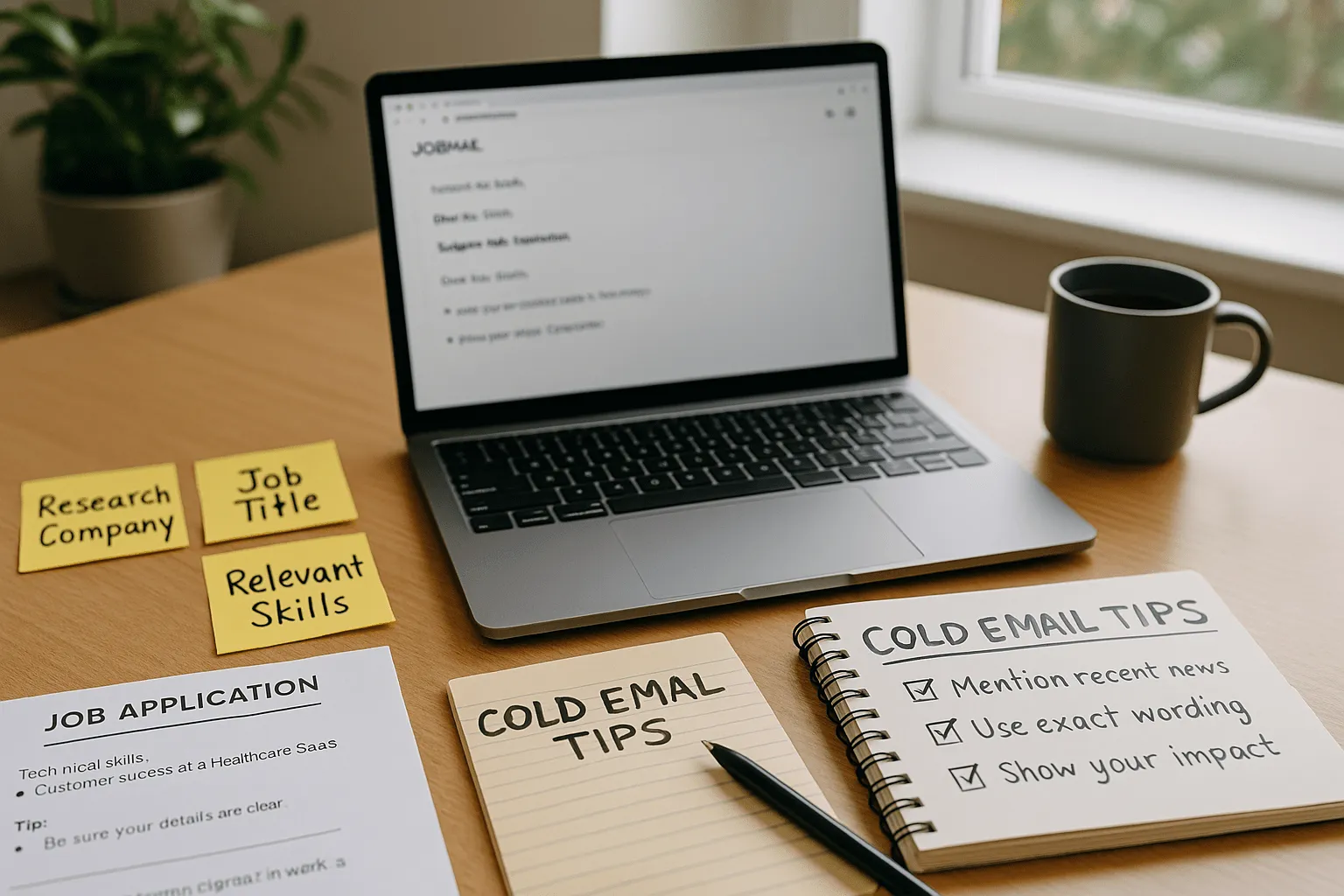
1. Start with a Company-Specific Hook
Mention something unique about the company name, like a recent product launch, blog post, or award. This shows that you did your research.
How to do it:
- Visit their company website and “About” page.
- Reference a fact about their company's journey or company's work.
- Say what genuinely impressed you (like their mission or design style).
Example: “I recently read your CEO’s interview on TechCrunch and was genuinely impressed by your focus on clean design in healthcare apps.”
Pro tip: A hook like this helps create an instant connection and grabs attention in the first line.
2. Use the Exact Job Title or Department Language
Mirror the words used in the job posting or job application listing.
How to do it:
- Copy the job title exactly (e.g., “Product Marketing Associate” instead of “Marketing Role”).
- Mention the department if relevant (e.g., “Sales Operations Team”).
- Align with the tone or keywords from the job description.
This helps your email match what the recruiter is looking for—especially if they’re scanning quickly or using filters.
3. Highlight Industry-Relevant Skills and Wins
Show that your skills align with the job and that you understand the specific industry.
How to do it:
- Mention 1–2 relevant skills used in similar roles.
- Briefly share a win: “I helped increase leads by 25% in a similar SaaS company.”
- Use phrases like “My background in [specific industry] taught me to…”
4. Link to a Resume or Project That Matches the Role
If you want to stand out, show proof of your skills. Just saying “I’m good at this” is not enough. Always add a resume link or a link to a real project. This makes your cold email for job more believable and useful.
How to do it:
- Use Google Drive, Dropbox, or your company website to share your resume link.
- Make sure the file opens easily—don’t ask hiring managers to request access.
- Pick a project that matches the job description or specific job.
- If you're applying for a design role, link to your portfolio. For developers, link to GitHub.
“One good link is better than ten vague sentences.” — Hiring Manager Insight Report, 2024
5. Tailor Your Cold Email Templates—Don’t Copy-Paste
Using a cold email template is fine—but don’t just copy it. Change the words so it fits the job posting and feels like it’s written for that one person. Recruiters get hundreds of cold email job inquiries. A lazy one won’t make it.
How to do it:
- Personalize the email body with the company name, job title, and one line about why you’re interested.
- Mention relevant experience that matches the role.
- Avoid sending the same email to potential employers—each should feel different.
- Add a short, strong call to action like “Can we set up a 10-minute call this week?”
6. Use Language That Matches the Industry Culture
Different industries speak differently. A cold email for a job at a law firm should sound more formal than one for a creative agency. Your email should reflect that.
How to do it:
- Read the job posting and company's website to catch their tone.
- Tech companies? Keep it casual and direct. Finance roles? Be more structured.
- Use industry keywords like “skills align” or “team collaboration” if you see them in the job boards or description.
- Avoid slang unless you’re sure it fits the industry culture.
This helps build an instant connection and shows you're a good fit.
How to Follow Up on an Unanswered Cold Email
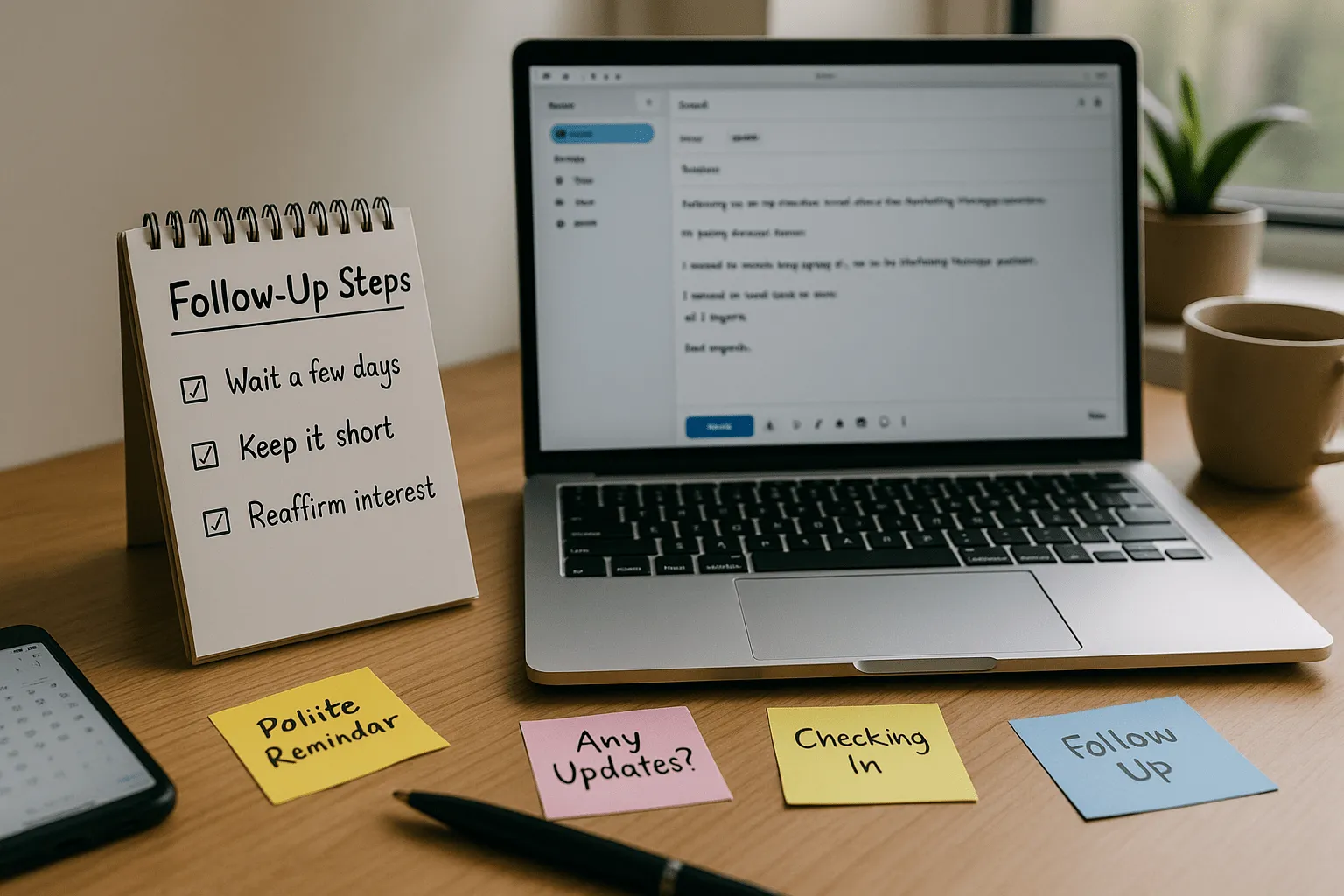
1. Wait 4–7 Days Before Following Up
Give the person enough time to read and respond.
How to do it:
- Don’t follow up too soon.
- Wait at least 4 days. 7 is better.
- Weekdays, especially mid morning, work best.
Why it works: Studies from HubSpot show that sending a follow up email after 5 days gets 30% more replies than same-day follow-ups.
This short wait also shows patience and professionalism.
2. Keep Your Follow Up Email Short and Polite
Be respectful. Don’t sound pushy or annoyed.
How to do it:
- Use a friendly subject line like: “Just checking in – [Your Name]”
- Mention your job application or cold email from earlier.
- Use simple opening lines: "Hi [Hiring Manager's Name], just wanted to follow up on my recent email about the [Job Title] role."
- Add a call to action like: “Would love to know if it’s a good time to chat or share my resume again.”
- Include your resume link if needed.
Tip: Use a clean email body. Avoid walls of text. Keep it under 150 words.
3. Reaffirm Your Interest in the Company
Remind them why you reached out.
How to do it:
- Mention something specific about the company’s work or company website.
- Reuse a line from your cold email for job that showed genuine interest.
- You can say: “I’m still very interested in the [specific job] and believe my relevant experience in [area] would make me a valuable asset to your team.”
4. Add Something New or Valuable
Your second email shouldn’t be a copy of the first. Always bring something new. This can be a skill you forgot to mention, a recent job posting that matches your profile, or a link to a project or resume link.
How to do it:
- Mention one specific thing that shows your relevant experience.
- Share an article, quick idea, or your personal blog post if it’s helpful.
- Add a line like: “Since I last wrote, I saw your team is working on [Project/Initiative]—I'd love to help.”
Tip: Show you’ve done your homework on the company website or hiring manager.
5. Ask a Clear, Low-Commitment Question
Don’t make the reader think too hard. A short, easy question can boost your chances of a successful response.
How to do it:
- Ask yes/no or “either-or” questions like:
- “Is it okay to send a quick video introduction?”
- “Should I connect with someone else for this specific job?”
- Make the email body short and skimmable.
- Mention your job title and skills align in one line.
Tip: A clear subject line like “Quick Follow-Up on [Job Title] Application” can help grab attention.
6. Send No More Than 2 Follow Ups (Max 3 Total Emails)
Too many emails feel pushy. Three emails total—initial + 2 follow ups—is best practice.
How to do it:
- Space them out over 4–7 days each.
- Keep your tone polite, respectful, and enthusiastic.
- Use a sign off like “Looking forward to hearing from you,” or “Thanks again for considering me.”
Cold Email Etiquette: What to Avoid (and What Gets Replies)
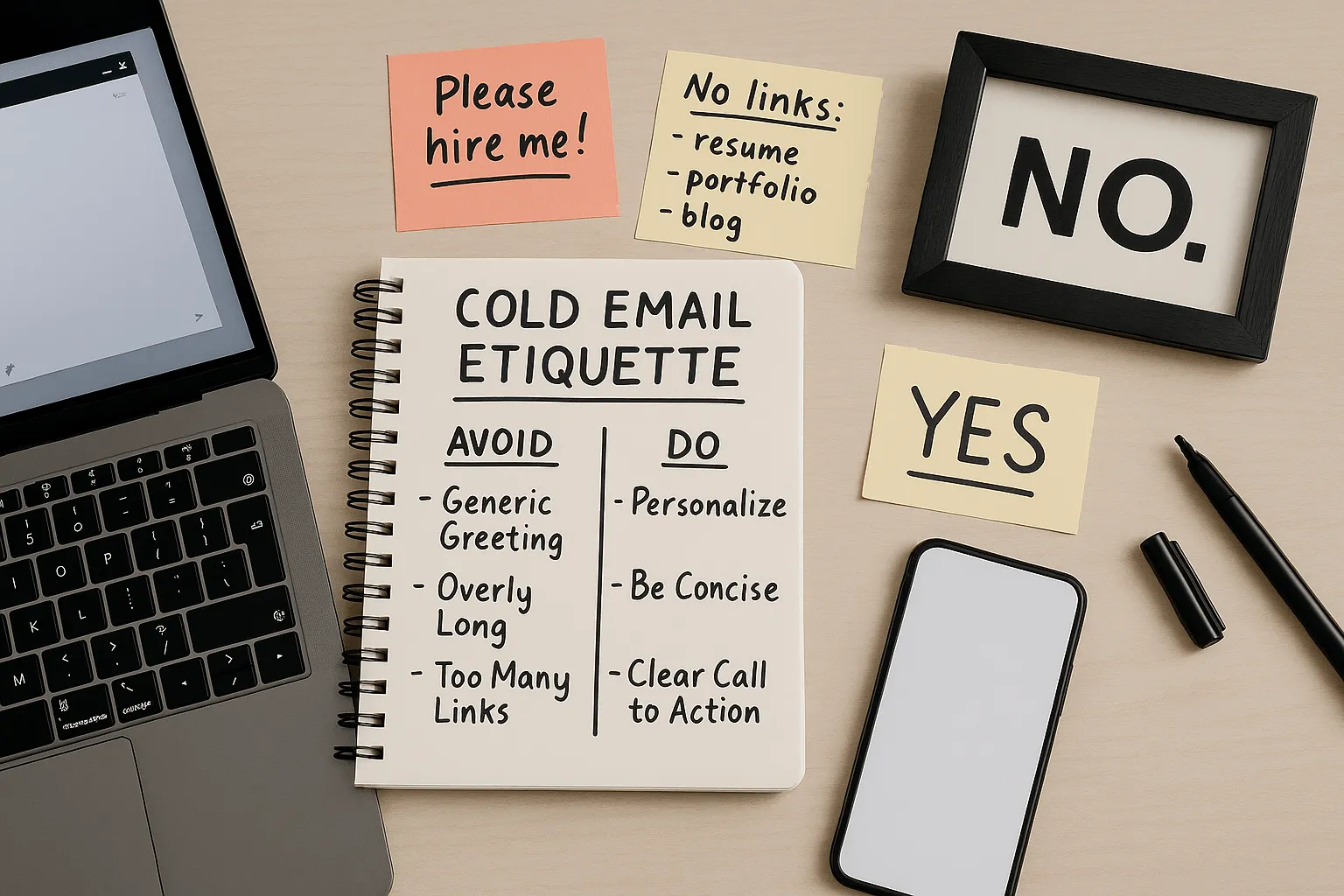
1. Don’t Use a Generic or Vague Subject Line
Your subject line is the first thing a hiring manager sees. If it's boring, your email might never get opened.
What to avoid:
- Subject lines like “Job Inquiry” or “Resume Inside.”
- No mention of the specific job or job title.
What to do instead:
- Write a compelling subject line that includes the job or company name.
- Example: “UX Designer Cold Email – Genuinely Impressed by [Company Name]”
2. Don’t Mass Email or BCC Multiple Companies
Sending the same cold email template to many potential employers shows a lack of effort. It also feels spammy.
What to avoid:
- “To Whom It May Concern”
- BCCing several company names at once
What to do instead:
- Mention the company website, the hiring process, or a shared interest.
- Show you did your research. That builds a quick instant connection.
3. Avoid Overselling or Sounding Desperate
You want to be confident—not pushy.
What to avoid: Phrases like “I’ll take anything” or “Please, I need this job.”
What to do instead:
- Mention how your skills align with the job description.
- Add one short line about your relevant experience or a link to your resume.
- Use a clear call to action like, “I’d love to learn more about the team’s goals this quarter.”
4. Don’t Write Long Paragraphs in the Email Body
If your cold email for job looks like a wall of text, people won’t read it. Hiring managers are busy. Big blocks of words feel heavy and boring. Use short sentences. Keep your email body clean and easy to skim.
Break it into:
- A short intro about who you are
- A quick sentence on why you’re writing
- A clear call to action
- Use bullet points if needed. Avoid long stories.
5. Avoid Informal or Sloppy Sign Offs
Don’t say things like “Cheers!” or “Later!” in a job email. This is not a chat with a friend. Use polite, simple endings. Some good examples:
- Best regards
- Thank you for your time
- Looking forward to your response
Also, add your job title (if relevant), phone number, and resume link. A solid sign off helps you sound professional.
6. Avoid Irrelevant Attachments or Overloading Links
Don’t send five links to your portfolio or a 10MB PDF. That’s a red flag. Many job seekers make this mistake.
Only attach what’s needed: your resume, cover letter, or a link to your company website if relevant. Too many attachments confuse or slow down the hiring process.
Ask yourself: Does this help me get a reply? If not, remove it.
Pro Tip: A single, clickable resume link works best for cold email job inquiries.
Bonus: How Cold Emailing Can Lead to Informational Interviews & Future Opportunities

Sending a cold email for job openings isn’t just about landing the job. It can also lead to informational interviews—short calls where you learn about a job title or company from an insider.
Many job seekers use this method to understand the hiring process and build real connections with potential employers.
Tip: If you show genuine interest and mention the company's work, some managers may offer to chat—even if they don’t have a specific job open.
Conclusion
Cold emailing for a job works—if you do it right. Don’t wait for job postings. Reach out directly to prospective employers. Show genuine interest. Share your skills, and ask for an informational interview. Even if there’s no opening now, it may lead to future opportunities. Smart job hunting means you shed light on your value before the hiring process starts.
“People who network through cold emails land jobs 33% faster.” – [LinkedIn Career Report, 2024]

